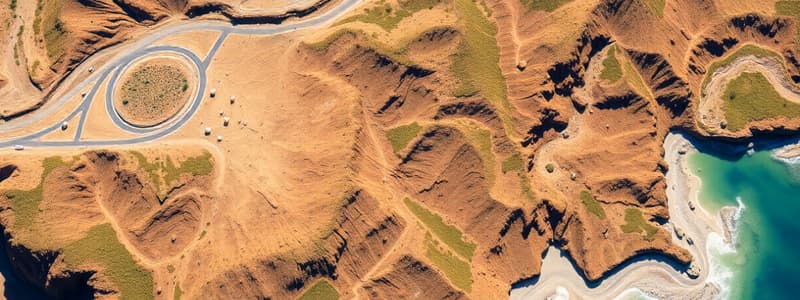Podcast
Questions and Answers
What does environmental determinism emphasize as the primary influence on human societies?
What does environmental determinism emphasize as the primary influence on human societies?
Which concept argues that while the environment may impose limitations, it does not solely dictate human choices?
Which concept argues that while the environment may impose limitations, it does not solely dictate human choices?
What type of analysis focuses specifically on an entire planet?
What type of analysis focuses specifically on an entire planet?
Which scale of analysis would focus on a specific city?
Which scale of analysis would focus on a specific city?
Signup and view all the answers
Which scale of analysis specifically looks at the characteristics of a single country?
Which scale of analysis specifically looks at the characteristics of a single country?
Signup and view all the answers
What characterizes a formal region?
What characterizes a formal region?
Signup and view all the answers
What is the primary defining feature of a functional region?
What is the primary defining feature of a functional region?
Signup and view all the answers
Which type of region is shaped largely by people's perceptions and beliefs?
Which type of region is shaped largely by people's perceptions and beliefs?
Signup and view all the answers
Which of the following examples best fits a formal region?
Which of the following examples best fits a formal region?
Signup and view all the answers
What distinguishes a perceptual region from other types of regions?
What distinguishes a perceptual region from other types of regions?
Signup and view all the answers
What does elevation refer to?
What does elevation refer to?
Signup and view all the answers
What is a map projection primarily used for?
What is a map projection primarily used for?
Signup and view all the answers
Which of the following defines absolute location?
Which of the following defines absolute location?
Signup and view all the answers
What does relative location describe?
What does relative location describe?
Signup and view all the answers
What is the function of a geographic information system (GIS)?
What is the function of a geographic information system (GIS)?
Signup and view all the answers
What are personal interviews primarily used for?
What are personal interviews primarily used for?
Signup and view all the answers
What does landscape analysis focus on?
What does landscape analysis focus on?
Signup and view all the answers
What is the primary purpose of photographic interpretation?
What is the primary purpose of photographic interpretation?
Signup and view all the answers
What is census data primarily used for?
What is census data primarily used for?
Signup and view all the answers
Which term describes the loss of unique place characteristics due to globalization?
Which term describes the loss of unique place characteristics due to globalization?
Signup and view all the answers
What is the primary purpose of satellite navigation systems?
What is the primary purpose of satellite navigation systems?
Signup and view all the answers
Which method involves collecting data from a distance using sensors?
Which method involves collecting data from a distance using sensors?
Signup and view all the answers
What type of data collection involves directly visiting a geographic location?
What type of data collection involves directly visiting a geographic location?
Signup and view all the answers
Which source provides insights into geographic places and cultures through personal experiences?
Which source provides insights into geographic places and cultures through personal experiences?
Signup and view all the answers
What do policy documents typically outline?
What do policy documents typically outline?
Signup and view all the answers
What is the concept of distance decay?
What is the concept of distance decay?
Signup and view all the answers
Which definition best describes time-space compression?
Which definition best describes time-space compression?
Signup and view all the answers
What does 'sustainability' refer to in environmental contexts?
What does 'sustainability' refer to in environmental contexts?
Signup and view all the answers
Natural resources are best defined as:
Natural resources are best defined as:
Signup and view all the answers
Which statement accurately describes land use?
Which statement accurately describes land use?
Signup and view all the answers
What does the concept of distance decay refer to?
What does the concept of distance decay refer to?
Signup and view all the answers
What is meant by time-space compression?
What is meant by time-space compression?
Signup and view all the answers
Which of the following best defines sustainability?
Which of the following best defines sustainability?
Signup and view all the answers
What is land use primarily concerned with?
What is land use primarily concerned with?
Signup and view all the answers
Natural resources are defined as what?
Natural resources are defined as what?
Signup and view all the answers
What defines a reference map?
What defines a reference map?
Signup and view all the answers
What is absolute distance?
What is absolute distance?
Signup and view all the answers
Which term describes the direction between two points expressed in relative positional terms?
Which term describes the direction between two points expressed in relative positional terms?
Signup and view all the answers
What does clustering refer to in geographic terms?
What does clustering refer to in geographic terms?
Signup and view all the answers
How is relative distance defined?
How is relative distance defined?
Signup and view all the answers
Study Notes
Regions
- Formal Region: Defined by shared characteristics like language, religion, or climate.
- Functional Region: Characterized by connections or interactions anchored around a specific node or activity.
- Perceptual/Vernacular Region: Based on subjective perceptions and beliefs influenced by cultural, historical, or emotional factors.
Environmental Determinism and Possibilism
- Environmental Determinism: Theory suggesting environment significantly shapes human societies and cultures.
- Possibilism: Concept stating the environment may limit choices but does not fully determine human actions.
Scales of Analysis
- Global Scale: Encompasses the entire planet.
- Regional Scale: Focuses on specific geographic regions, such as continents or subregions.
- National Scale: Centers on individual countries.
- Local Scale: Targets specific cities, towns, or neighborhoods.
Human-Environment Interaction
- Distance Decay: The decrease in frequency or intensity of a phenomenon with increased distance from its origin.
- Time-Space Compression: A phenomenon where improvements in transportation and communication reduce perceived distances between places.
- Pattern: A recurring geographic arrangement or configuration of features.
- Sustainability: The ability of systems to endure without depleting resources or causing lasting environmental damage.
- Natural Resources: Items in nature usable for producing goods or providing services.
- Land Use: Classification of land based on its utilization, such as agricultural, industrial, or residential purposes.
Geographic Data and Analysis
- Elevation: Measurement of landform height above sea level.
- Map Projection: A method for depicting Earth's spherical surface onto a flat map, resulting in unavoidable distortions.
- Absolute Location: Precise coordinates of a place on Earth based on latitude and longitude.
- Relative Location: A place's position concerning other locations.
Geographic Data Sources
- Geographic Information Systems (GIS): Software for capturing, storing, analyzing, and displaying geographic data.
- Global Positioning Systems (GPS): Satellite-based navigation technology providing precise location data.
- Satellite Navigation Systems: Includes GPS and similar systems like GLONASS and Galileo.
- Remote Sensing: Gathering data about Earth's surface from distance, using satellites, aircraft, or drones.
- Field Observations: Direct data collection through visits to geographic locations.
- Media Reports: Information from news articles, documentaries, or other media sources regarding geographic events.
- Travel Narratives: Personal accounts that offer insights into geographical places and cultures.
- Policy Documents: Official documents detailing policies on land use or environmental management.
Key Concepts in Human-Environment Interaction
- Distance Decay: Similar to previous definition, focused on its impact on phenomena over distance.
- Time-Space Compression: Reflects changes in perceived distance due to technology influences.
Sustainability and Natural Resources
- Sustainability: Emphasizes long-term maintenance without resource depletion or environmental harm.
- Natural Resources: Fundamental materials available in nature for human use.
Land Use
- Land Use: Differentiates how areas are designated based on their functional purposes.
Geographic Terms
- Personal Interviews: Gathers insights from individuals knowledgeable about geographic topics.
- Landscape Analysis: Studies the physical features of a geographic area.
- Photographic Interpretation: Involves analyzing photographs for geographic feature insights.
- Census Data: Information collected regarding population and housing characteristics in a region.
- Satellite Imagery: Provides aerial views to analyze Earth's surface in detail.
- Placelessness: Loss of unique identity in places due to globalization effects.
- Flows: Movements of people, goods, ideas, or information between various locations.
Map Terms
- Reference Map: Displays geographic features such as roads and cities.
- Thematic Map: Focuses on specific themes or data sets like population density or climate data.
- Absolute Distance: Measured distance between two points in units (miles, kilometers).
- Absolute Direction: Exact directional angle between two points, measured in degrees.
- Relative Distance: Perceived distance influenced by time, cost, or effort.
- Relative Direction: Direction indicated relative to other locations (e.g., "northeast").
- Clustering: Concentration of geographic features within an area.
- Dispersal: Spread of geographic features across a broader area.
Studying That Suits You
Use AI to generate personalized quizzes and flashcards to suit your learning preferences.
Description
Explore the various types of regions and theories in human geography through this quiz. Delve into the concepts of environmental determinism and possibilism, as well as different scales of analysis from local to global. Test your understanding of how humans interact with their environments.




